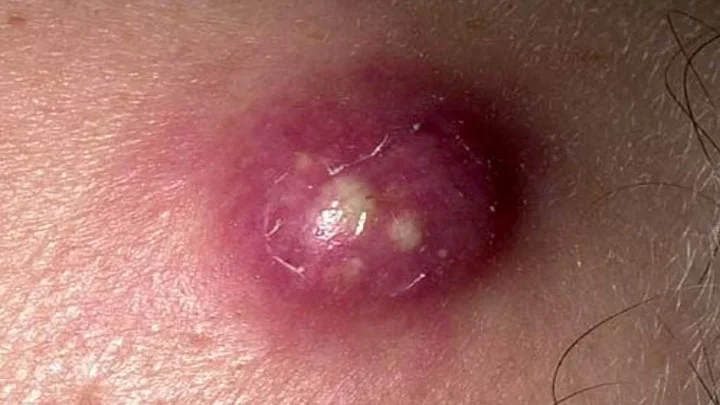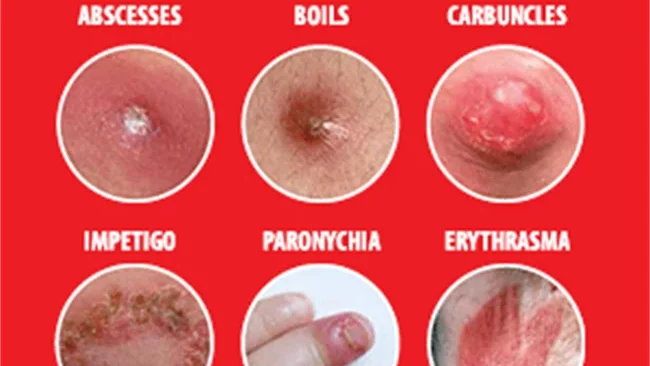Bacterial Skin Infections: A Comprehensive Guide to Understanding, Diagnosis, and Treatment
Introduction:
Bacterial skin infections represent one of the most significant health challenges worldwide, affecting millions of people annually and contributing substantially to global healthcare burden. Recent global burden studies indicate that bacterial skin diseases, including pyoderma and cellulitis, have an age-standardized incidence of 169.72 million cases globally, making them among the most common dermatological conditions encountered in clinical practice.
The skin, being the largest organ of the human body, serves as our primary defense against environmental pathogens. It maintains homeostasis, protects underlying tissues and organs from mechanical injury, damaging substances, and ultraviolet radiation from the sun. However, when this protective barrier is compromised, bacterial pathogens can establish infections that range from superficial skin involvement to life-threatening systemic diseases.
In the United States alone, the burden of acute skin infections is substantial, with Staphylococcus aureus and Streptococcus species being the most common causes. The emergence of antibiotic-resistant strains, particularly methicillin-resistant Staphylococcus aureus (MRSA), has significantly complicated treatment approaches and increased healthcare costs over the past two decades.
Epidemiology and Global Burden
The epidemiology of bacterial skin infections has evolved significantly in recent years. A comprehensive study analyzing skin and soft tissue infections in the United States between 2010 and 2020 found that 5.4 million patients experienced 9.1 million episodes, with an incidence of 77.5 per 1000 person-years of observation. This data underscores the persistent and substantial burden these infections place on healthcare systems.
Tropical and Resource-Poor Settings
In tropical and resource-poor settings, skin infections of bacterial, viral, fungal, or parasitic origin are the commonest cause of disease, with skin neglected tropical diseases (NTDs) forming about 10% of all skin diseases in most communities. The prevalence is particularly concerning in areas with poor sanitation, overcrowding, and limited access to healthcare services.
Changing Demographics and Risk Factors
The epidemiology of skin and soft tissue infections is changing, with increasing rates of chronic ulcers that frequently develop complications. Incidence rates of chronic ulcers increased from 11.3 to 18.2 per 1000 person-years over the study period, and complicated disease increased from 3.5 to 6.3 per 1000 person-years. This trend reflects the aging population and increasing prevalence of conditions such as diabetes and peripheral vascular disease.
Pyoderma: The Foundation of Bacterial Skin Disease
Pyoderma represents a group of pyococcal dermatoses that are generally purulent in nature. In tropical countries, pyoderma is a particularly common problem, especially during summer and monsoon seasons when heat and humidity create optimal conditions for bacterial proliferation.
Primary Causative Organisms
The two most important pyogenic organisms responsible for bacterial skin infections are:
- Staphylococcus aureus – Predominantly causes follicular infections
- Streptococcus pyogenes (Group A β-hemolytic streptococcus) – Primarily responsible for erysipelas and cellulitis
Other organisms occasionally encountered in pyodermas include Proteus, Pseudomonas, and Coliform bacilli, particularly in complicated infections or immunocompromised patients.
Classification of Bacterial Skin Infections
Staphylococcus aureus Infections
Staphylococcal skin infections can be broadly categorized into two main types:
I. Direct Infection of Skin and Adjacent Tissues
a) Impetigo Impetigo is a superficial skin infection characterized by clusters of vesicles or pustules. Two forms exist:
- Non-bullous impetigo: Manifests as vesicles that rupture and develop honey-colored crusts
- Bullous impetigo: Features larger bullae that burst to expose larger bases covered with honey-colored varnish or crust
b) Ecthyma A deeper, ulcerative form of impetigo that extends through the epidermis into the dermis, potentially causing scarring. Ecthyma gangrenosum, caused by Pseudomonas aeruginosa, usually occurs in people with compromised immune systems.
c) Folliculitis Folliculitis is a bacterial infection of hair follicles that usually manifests as superficial pustules or inflammatory nodules surrounding hair follicles. While Staphylococcus aureus is the primary cause, Pseudomonas aeruginosa can cause “hot-tub folliculitis” due to inadequate water treatment with chlorine or bromine.
d) Furuncules (Boils) Furuncles are skin abscesses involving hair follicles and surrounding tissue. They present as tender, red, swollen nodules filled with pus.

e) Carbuncles Carbuncles represent clusters of furuncles connected subcutaneously, causing deeper suppuration and more extensive scarring than individual furuncles.
f) Sycosis Barbae A deeper form of folliculitis affecting the bearded area, commonly seen in men who shave regularly.
II. Cutaneous Disease Due to Bacterial Toxin Effects
a) Staphylococcal Scalded Skin Syndrome A toxin-mediated condition primarily affecting infants and young children.
b) Toxic Shock Syndrome A severe systemic condition caused by staphylococcal toxins.
β-Hemolytic Streptococcus Infections
I. Direct Skin or Subcutaneous Infections
a) Impetigo (Non-bullous) Streptococcal impetigo typically presents without the bullous formation seen in staphylococcal variants.
b) Ecthyma The streptococcal form involves deeper tissue invasion compared to superficial impetigo.
c) Erysipelas Erysipelas is a superficial cellulitis with dermal lymphatic involvement, characterized by shiny, raised, indurated, and tender plaque-like lesions with distinct margins. It most commonly affects the face and legs and is often accompanied by high fever, chills, and malaise.
d) Cellulitis Cellulitis represents acute bacterial infection of the skin and subcutaneous tissue, most often caused by streptococci or staphylococci. It presents as an area of spreading redness, warmth, swelling, and tenderness.
e) Necrotizing Fasciitis This represents the most severe form of bacterial skin infection, involving rapid necrosis of subcutaneous tissue and fascia. It requires immediate surgical intervention and aggressive antibiotic therapy.
II. Secondary Infections
Streptococci commonly cause secondary infections in pre-existing skin conditions such as eczema.
Special Considerations: MRSA and Antibiotic Resistance
The MRSA Challenge
Methicillin-resistant Staphylococcus aureus (MRSA) has emerged as a significant clinical challenge. In a large observational study, 81% of culturable skin and soft tissue infections were caused by S. aureus, and 46% of these were MRSA. This statistic highlights the critical importance of appropriate antibiotic selection and the need for culture-guided therapy.
Risk Factors for MRSA Infection
Important risk factors for MRSA skin and soft tissue infections include previous history of MRSA infection, advanced age, chronic open wounds, underlying chronic disease, and frequent contact with healthcare facilities.
MRSA Antibiotic Resistance Profile
The resistance profile of MRSA infections presents significant therapeutic challenges:
- 100% resistance to β-lactam antibiotics
- 94% resistance to clindamycin and erythromycin
- 89% resistance to ciprofloxacin
- 56% resistance to trimethoprim-sulfamethoxazole
- 33% resistance to tetracycline
- Only 3% resistance to rifampin and fusidic acid
- 2% resistance to mupirocin
Community-Associated vs. Healthcare-Associated MRSA
MRSA infections are now categorized into healthcare-associated MRSA (HA-MRSA) and community-associated MRSA (CA-MRSA). CA-MRSA often begins as painful skin boils and is usually spread by skin-to-skin contact among groups such as high school wrestlers, child care workers, and people living in crowded conditions.
Other Important Bacterial Skin Infections
Hidradenitis Suppurativa
Hidradenitis suppurativa is a chronic, scarring inflammation of apocrine glands affecting the axillae, groin, and areas around the nipples and anus. While not primarily infectious, secondary bacterial colonization often complicates this condition.
Erythrasma
Erythrasma is an intertriginous infection caused by Corynebacterium minutissimum. It is most common among patients with diabetes and people living in tropical climates. The condition can be diagnosed using Wood’s lamp examination, which reveals coral-red fluorescence.
Laboratory Diagnosis
Specimen Collection Methods
Proper specimen collection is crucial for accurate diagnosis:
- Skin biopsy – For deep or chronic infections
- Skin swab – For superficial infections
- Pus swab – From abscesses or purulent lesions
- Nasal/skin swab – For carrier state detection
Suspected Organisms by Clinical Presentation
- Impetigo: Group A Streptococcus, Staphylococcus aureus
- Folliculitis: Staphylococcus aureus, Pseudomonas aeruginosa
- Furuncles and Carbuncles: Staphylococcus aureus
- Cellulitis: Group A Streptococcus, Staphylococcus aureus, Haemophilus influenzae
- Erysipelas: Group A Streptococcus
- Necrotizing fasciitis: Group A Streptococcus, Clostridium perfringens, Bacteroides fragilis, Enterobacteriaceae, Pseudomonas aeruginosa
Treatment Approaches
General Principles of Therapy
The management of bacterial skin infections follows several fundamental principles:
Addressing Predisposing Factors
Local Factors:
- Proper wound care for traumas
- Management of pressure points
- Control of excessive sweating
- Treatment of insect bites
- Management of pre-existing dermatological conditions
- Investigation and treatment of carrier sites (nose, axilla, perineum)
Systemic Factors:
- Optimal control of diabetes mellitus
- Correction of nutritional deficiencies
- Management of immunodeficiency states
Local Therapy
Topical Management:
- Cleaning with soap and water followed by weak potassium permanganate (KMnO₄) solution
- Removal of crusts using KMnO₄ solution
- Application of antibacterial creams or ointments
Systemic Antibiotic Therapy
Treatment of Folliculitis
For most folliculitis cases caused by S. aureus:
- Topical therapy: Clindamycin lotion or gel, Benzoyl peroxide wash
- Systemic therapy: For extensive involvement, Cephalexin orally
For Recurrent or Resistant Cases:
- Gram staining and culture of pustules to rule out gram-negative bacteria or MRSA
- Nasal culture to detect staphylococcal carriage
- Potassium hydroxide wet mount of plucked hair to exclude fungal folliculitis
MRSA Treatment: Treatment for MRSA usually requires specific antibiotics, with options including Clindamycin alone, Trimethoprim-sulfamethoxazole or Tetracycline in combination with a beta-lactam antibiotic, or Linezolid alone.
Treatment of Cellulitis
Oral Therapy (for mild infections):
- Dicloxacillin or Cephalexin
- Levofloxacin or Moxifloxacin for patients with adherence concerns
Intravenous Therapy (for serious infections):
- Oxacillin or Nafcillin
Supportive Care:
- Immobilization and elevation of affected area to reduce edema
- Cool, wet dressings for local comfort
Management of Staphylococcal Carriage
For patients with recurrent staphylococcal infections, elimination of carriage is essential:
Nasal and Perineal Care:
- Rifampicin
- Clindamycin
- Topical Mupirocin to nasal passages
- Replacement therapy with less pathogenic S. aureus strains
Treatment of Severe Infections
Necrotizing Fasciitis
This medical emergency requires:
- Immediate surgical debridement
- Aggressive antibiotic therapy
- Amputation if necessary to save life
The prognosis remains poor without early, aggressive intervention.

Prevention Strategies
Individual Prevention Measures
Personal Hygiene:
- Regular bathing with antibacterial soap
- Proper wound care and prompt treatment of cuts and abrasions
- Avoiding sharing personal items such as towels, razors, and clothing
- Regular hand hygiene, especially in healthcare settings
Risk Factor Modification:
- Optimal management of diabetes and other chronic conditions
- Maintenance of healthy skin barrier through proper moisturization
- Avoiding activities that may compromise skin integrity when possible
- Prompt treatment of underlying dermatological conditions
Community Prevention
Healthcare Settings:
- Strict adherence to infection control protocols
- Proper isolation of infected patients when indicated
- Regular surveillance for MRSA and other resistant organisms
- Staff education and training on prevention measures
Community Settings:
- Education programs in schools and athletic facilities
- Proper cleaning and disinfection of shared equipment
- Awareness campaigns about the risks of antibiotic misuse
Emerging Challenges and Future Directions
Antibiotic Resistance
The high prevalence of drug-resistant organisms and the increasing number of immunocompromised patients receiving biologic immunosuppressive therapy are critical reasons for the complexity of treating bacterial skin infections. This trend necessitates the development of new therapeutic approaches and stricter antimicrobial stewardship programs.
Novel Treatment Approaches
Research is ongoing into alternative treatment modalities, including:
- Bacteriophage therapy for resistant infections
- Immunomodulatory treatments
- Novel topical antimicrobial agents
- Combination therapies targeting biofilm formation
Global Health Implications
The World Health Organization has recognized the need for greater investments in neglected tropical diseases, including skin infections, to accelerate efforts to achieve the 2030 roadmap targets. This global perspective emphasizes the importance of addressing bacterial skin infections as a public health priority.
Conclusion
Bacterial skin infections remain a significant global health challenge, affecting millions of people worldwide and imposing substantial economic and social burdens. The complexity of these infections has increased with the emergence of antibiotic-resistant organisms, particularly MRSA, which has fundamentally changed treatment approaches and outcomes.
The key to successful management lies in early recognition, appropriate diagnostic testing, and prompt initiation of targeted therapy. The role of qualified dermatologists and specialized derma and dental clinics cannot be overstated in providing comprehensive care that encompasses accurate diagnosis, effective treatment, and preventive education.
A history of bacterial skin disease greatly increases the risk for subsequent episodes, and patients with comorbid conditions that predispose them to infection, particularly diabetes, are at an upward trend of risk. This emphasizes the importance of addressing underlying risk factors and implementing comprehensive prevention strategies.
As we move forward, the focus must be on developing new treatment modalities, implementing effective antimicrobial stewardship programs, and addressing the global disparities in access to quality dermatological care. Only through a coordinated approach involving healthcare providers, researchers, policymakers, and communities can we hope to reduce the burden of bacterial skin infections and improve outcomes for affected patients worldwide.
The integration of advanced diagnostic techniques, personalized treatment approaches, and comprehensive preventive strategies offers hope for better management of these challenging conditions. Continued research into the pathophysiology of bacterial skin infections, development of novel therapeutic agents, and implementation of evidence-based prevention programs will be essential for addressing this ongoing public health challenge.
For comprehensive evaluation and treatment of bacterial skin infections, patients are encouraged to seek care from qualified dermatologists at specialized derma & dental clinic, where advanced diagnostic capabilities and evidence-based treatment protocols ensure optimal outcomes.

